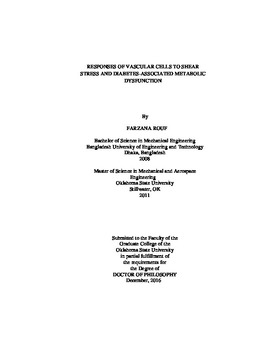| dc.contributor.advisor | Santhanakrishnan, Arvind | |
| dc.contributor.advisor | Lloyd, Pamela G. | |
| dc.contributor.author | Rouf, Farzana | |
| dc.date.accessioned | 2018-06-25T13:38:30Z | |
| dc.date.available | 2018-06-25T13:38:30Z | |
| dc.date.issued | 2016-12 | |
| dc.identifier.uri | https://hdl.handle.net/11244/300265 | |
| dc.description.abstract | Cardiovascular disease (CVD) is the leading cause of death worldwide, accounting for 30% of all deaths. Coronary artery disease (CAD - narrowing of arteries), most common type of CVD, results in altered shear stress that can affect platelets and endothelial cells (EC). Activated platelets and EC can express/secrete adhesion ligands, and inflammatory molecules, further promoting CVD. Previous functional studies utilized constant shear stress to activate either platelets or EC without considering EC/platelet communication. These conditions are not physiological. Therefore, we exposed platelets and EC together to physiological dynamic shear stress to study platelet and EC responses and signal pathway activation. Our results indicated that platelets showed increased PECAM-1 and decreased GPIbalpha and GPIIb expression, whereas EC showed increased soluble vWF expression and EMP generation in response to dynamic shear stress. We also found signaling pathway (MAPK and NF-kB) activation. Our results demonstrated that platelets enhance shear induced EC activation, which in turn leads to platelet-EC crosstalk that returns the activation level towards equilibrium by modulating platelet activation. | |
| dc.description.abstract | Arteriogenesis (remodeling of collateral arteries), a natural defense mechanism, attempts to preserve blood flow during CAD. Placental growth factor (PLGF) is a key arteriogenic growth factor. Diabetes is known to inhibit arteriogenesis, but how diabetes affects platelet uptake/release of PLGF, EC PLGF expression, and the underlying molecular mechanisms regulating PLGF has not been studied. Our results demonstrated that 1) platelets can take up PLGF; 2) simulated acute hyperglycemia (glucose treatment) and chronic hyperglycemia (AGE treatment) are the major contributors to impaired PLGF expression in cardiac and skeletal muscle cells; 3) elevated dynamic shear stress increases PLGF production by EC, and AGE can negatively modulate this effect; and 4) Western diet consumption can increase AGE levels in mouse skeletal muscle. We conclude that inhibition of PLGF expression by AGE contributes to impaired arteriogenesis in diabetes. | |
| dc.description.abstract | Findings from this study have advanced our knowledge of how platelets and EC interact in various physiological and pathophysiological settings, suggesting their contribution to CAD development. We also identified a possible mechanism for impaired arteriogenesis in diabetic patients. Thus, our study has the potential to lead to therapeutic innovations. | |
| dc.format | application/pdf | |
| dc.language | en_US | |
| dc.rights | Copyright is held by the author who has granted the Oklahoma State University Library the non-exclusive right to share this material in its institutional repository. Contact Digital Library Services at lib-dls@okstate.edu or 405-744-9161 for the permission policy on the use, reproduction or distribution of this material. | |
| dc.title | Responses of vascular cells to shear stress and diabetes-associated metabolic dysfunction | |
| dc.contributor.committeeMember | Kalkan, A. Kaan | |
| dc.contributor.committeeMember | Lacombe, Veronique A. | |
| osu.filename | Rouf_okstate_0664D_14862.pdf | |
| osu.accesstype | Open Access | |
| dc.type.genre | Dissertation | |
| dc.type.material | Text | |
| thesis.degree.discipline | Mechanical and Aerospace Engineering | |
| thesis.degree.grantor | Oklahoma State University | |
